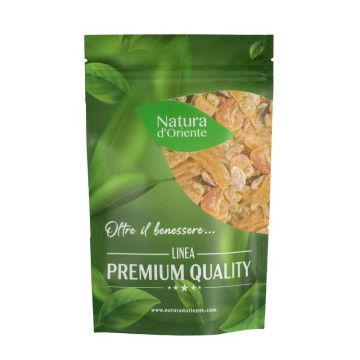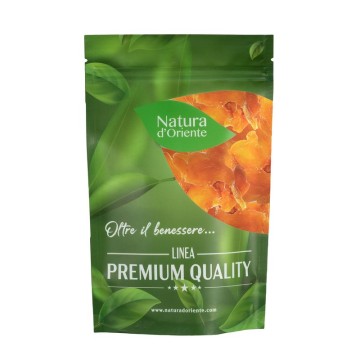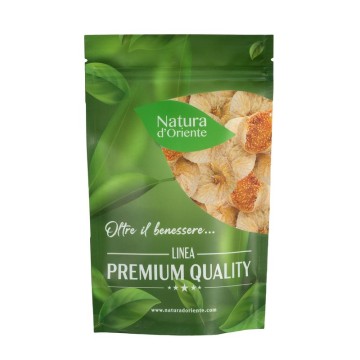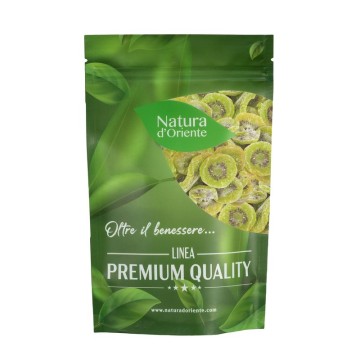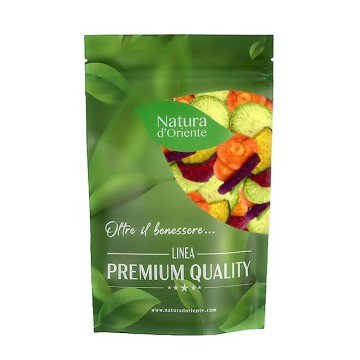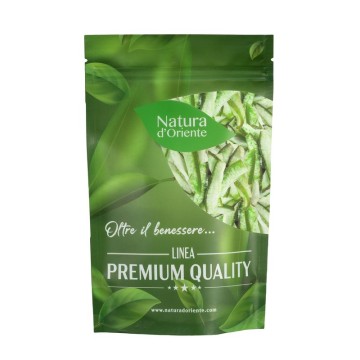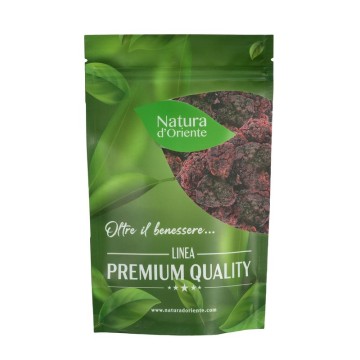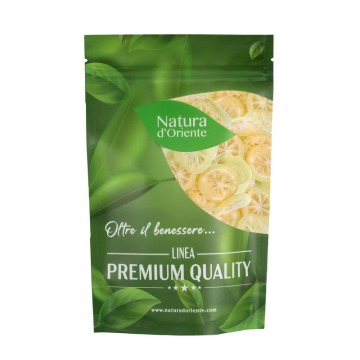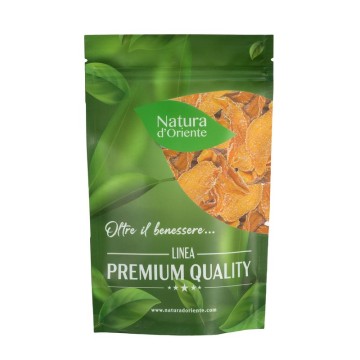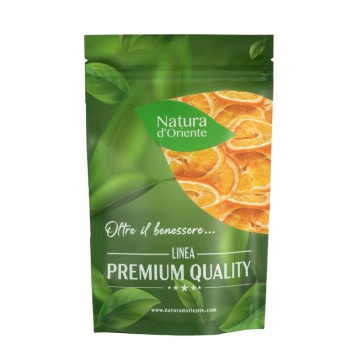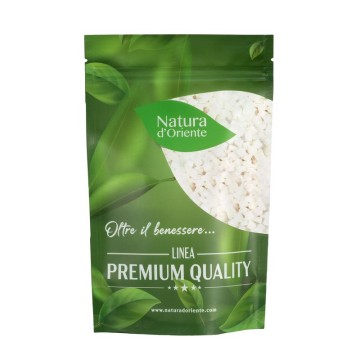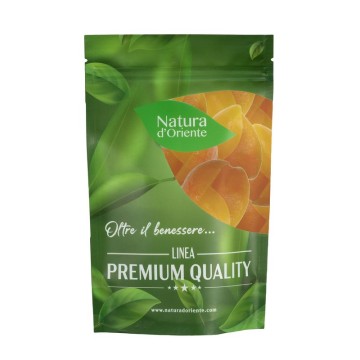Natural dehydrated ginger with pure licorice
Known for centuries as a beneficial root for taste and health, ginger is available today in many versions, including dehydrated ones, and with the addition of delicious aromas and flavors. As in this version of natural ginger with pure licorice, to amplify the excellent properties of the two ingredients.
Natural dried ginger with licorice: properties and benefits
Appreciated as a spice since ancient times, in Asian cuisine in particular, today ginger has become a valuable flavoring, and now widespread all over the world. We find it in the form of powder, dehydrated slices of ginger, ginger flavoring for ginger drink, and so on.
Oriental medicine used it for its beneficial properties as a natural anti-inflammatory, digestive, anti-nausea and anti-dizziness substance - in some cases even as an aphrodisiac.
Nowadays, however, ginger is known to most as a food able to relieve sore throats, and is used a lot in herbal teas to calm the symptoms of hoarseness and cold.
The active ingredients of the plant, which allow these healthy benefits, are concentrated in the root, the rhizome, where there are substances known today as gingerols, shogaoli, resins and mucilages.
The pungent flavor comes from the polyphenols, gingerols and shogaols we mentioned, which are responsible for the antioxidant and anti-nausea properties of natural ginger.
Its property for the protection of the gastric mucosa makes it a valid food to promote proper digestion, counteracting bacterial fermentation and favoring the elimination of gases.
Natural ginger stimulates assimilation during gastrointestinal functions, and in connection with this property, it provides several antiemetic properties. It is good for limiting stomach pain and motion sickness (symptoms such as dizziness, nausea and regurgitation). In fact, the intake of ginger helps to counteract the symptoms of esophageal reflux.
its properties as a food preservative. It was also considered a magical food, because preserving the food, it seemed like a supernatural food.
In oriental kitchens it was used to flavor sweet and savory dishes, and in the West today it is used a lot in powdered versions for dishes, drinks, cocktails. Slices of dehydrated ginger, with or without sugar, are also very popular.
The plant is now cultivated throughout the tropical and subtropical belt, and the underground part (the rhizome), is cleaned if you want to use fresh ginger or it is dehydrated to obtain sun-dried ginger, transformed into powder and sold as a spice.
For sale, ginger is available in the form of fresh or dried root, powdered or extracted; otherwise, like candied ginger using only natural sugar.
From fresh ginger it can be dehydrated, sliced, diced, ground or candied. It is dehydrated without added sugar, thus remaining natural. It can be flavored, as in the version of natural dehydrated ginger with pure licorice.
Plant and Fruit
The Zingiber officinale plant belongs to the Zingiberaceae family, and was born in the tropical Far East, where it probably originated wild in Malaysia.
It is an evergreen perennial plant, which has a fleshy and branched rhizome (an underground shoot).
From the rhizome are born hollow stems, formed by leaves, and other stems with yellow-green inflorescences; in addition to the flowers, small and white. Ginger bushes expand to up to half a meter in width and the same size in height.
The fruit is woody and usually not eaten, while from the rhizome, as we know, we get the spice we know in our kitchens, or the dehydrated slices. The rhizome has a spicy taste, and is harvested from the moment the plant has accumulated essential oil, ie during the cold season between January and February.
Ginger can be grown as an indoor plant or in home gardens, however it grows in warm climates, where temperatures do not drop below 5 ° C.
Nutritional values of natural dehydrated ginger
Dried ginger has a moderate caloric intake , providing about 350 Kcal for every 100 grams. In the natural version, sliced ginger is composed of natural sugars (about 60 g), with zero fat, and about 2% fiber.
The important active ingredients are found in the essential oil, composed of zingiberene, and polyphenols, gingerols and shogaoli that make its flavor pungent.
Sliced natural ginger contains these phenolic substances studied for their properties, 6-gingerol which when dried turns into 6-shogaol.
Ginger contains about 5 mg of vitamin C per 100 grams, and good doses of vitamin B1 and vitamin B3.
Dehydration enhances the properties of fresh ginger, making it spicier in taste, and beneficial in effect.
How to consume dehydrated ginger with licorice
The version of natural dehydrated ginger with pure licorice, has a decidedly pungent and intense flavor , due to the two ingredients. It is appreciated as a snack, a hunger breaker that satisfies and leaves the palate feeling full.
Furthermore, it can be useful for flavoring dishes such as soups and soups, if not for decorating desserts such as cakes or biscuits, cupcakes, muffins, ice creams and semifreddo.
In the version of sliced licorice ginger, it is often consumed as an energy snack, thanks to the sugars contained and the tonic properties of licorice. It can be used to create energy bars suitable for those who practice physical activity.
It is also inserted in thin slices in yogurt, smoothies, dried fruit mixes, and in some fruit salads where the pungent aroma and flavor of ginger and licorice blend well with the ingredients.
Dehydrated ginger: side effects and contraindications
There are no particular contraindications to taking natural ginger, but a possible intolerance to ginger itself, or to licorice, must be considered.
It is important not to exceed the doses of sliced ginger, as an overload in the body can cause heartburn.
Due to its fluidifying properties, even if not definitively proven, it is not recommended for people who use anticoagulant drugs. For those suffering from high blood pressure, it is recommended to choose a version of sliced ginger that does not include pure licorice, like this one.
As always with dried and high-sugar foods, excessive use of natural dehydrated ginger is not recommended.
The association with licorice is useful for strengthening the immune system, but also for enhancing the digestive benefits. Licorice, in fact, always through its roots, makes available properties against gastro-intestinal disorders, fights constipation and promotes digestion.
In particular, in the natural dehydrated ginger with licorice, the two foods can alleviate the symptoms of gastric ulcer, thanks to the double protection on the mucous membrane of the stomach.
We know that licorice is suitable for those suffering from low blood pressure, since an active ingredient contained in it, glycyrrhizin (glycyrrhizic acid), regulates the levels of the hormone aldosterone, involved in blood pressure.
The mix of ginger and licorice can also be doubly effective against fat cough, sinusitis and colds.
Sliced natural ginger, especially in combination with licorice, is useful against halitosis, to promote a fresh and fragrant breath.
Among the various health benefits, dried ginger has antioxidant properties, due to gingerol. It counteracts the oxidation of cells and their aging, creating an antioxidant enzyme: it inhibits free radicals with an effect that seems greater than that of vitamin E, with the concentration of polyphenols.
Ginger is also known as a beneficial food for the cardiovascular system, since gingerol and volatile oils can have a stimulating effect on the regularity of the vascular system. And in this union with licorice, it can be useful to regulate its action on pressure.
Origins and History of cultivation
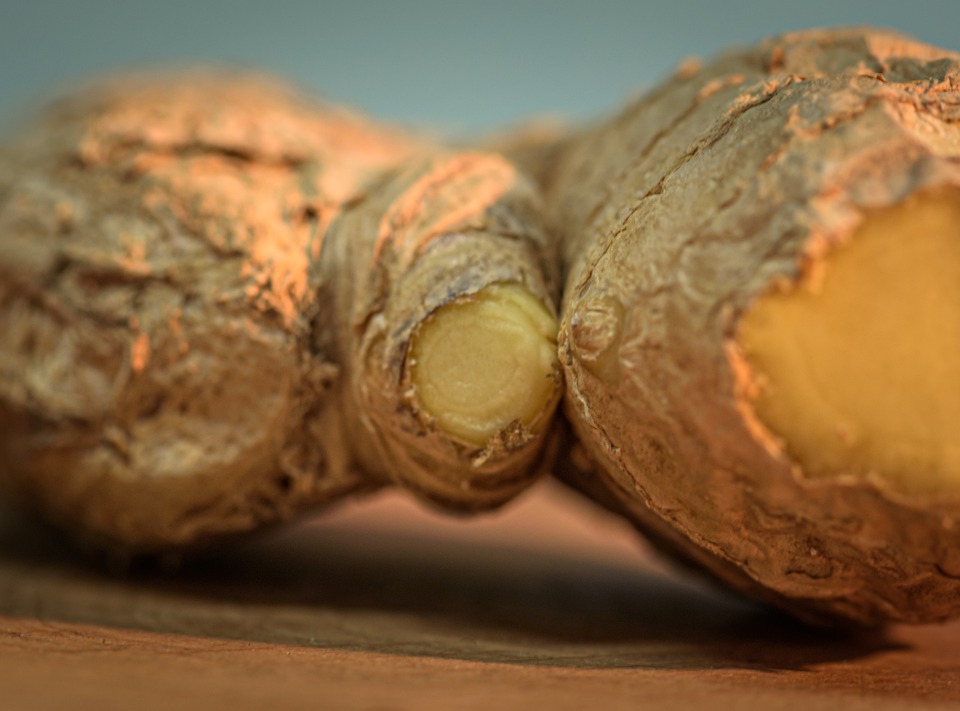 Ginger is a perennial herbaceous plant, native to tropical Asia, therefore from the East. From its rhizome, the underground part defined as the root, the aromatic and spicy spice, known since ancient times, is obtained.
Ginger is a perennial herbaceous plant, native to tropical Asia, therefore from the East. From its rhizome, the underground part defined as the root, the aromatic and spicy spice, known since ancient times, is obtained.
From his writings, Confucius used ginger (5th century BC) in ancient China, and in fact in Chinese medicine it was a hot element, to fight the cold and rebalance the body.
It was also considered a valuable food by Greeks and Romans, in fact the doctor Dioscorides Pedanio (1st century AD) prescribed it to warm and calm the stomach. Among the Arab peoples, ginger was known as an energizer and aphrodisiac.
Ginger in the Middle Ages was called "gengevo" (hence the English gingifer and the current ginger), and was a precious spice, while in the sixteenth century it reached the Americas thanks to the Spanish trade. It began to spread all over the world, where many populations knew the

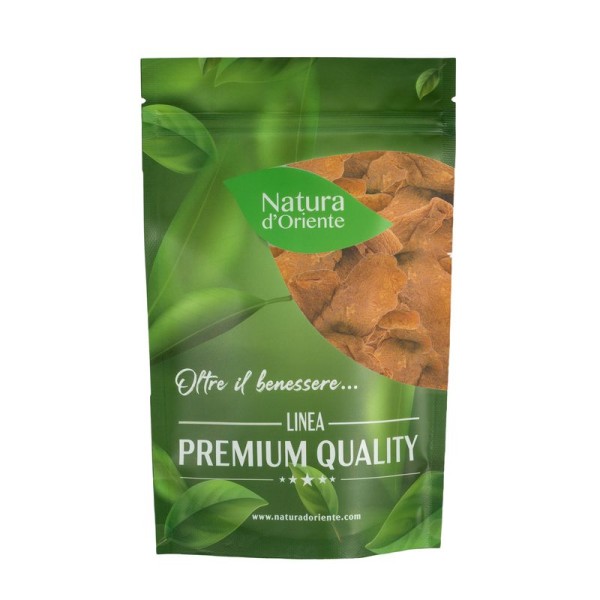







 No reward points for this product.
No reward points for this product.
 Ginger is a perennial herbaceous plant, native to tropical Asia, therefore from the East. From its rhizome, the underground part defined as the root, the aromatic and spicy spice, known since ancient times, is obtained.
Ginger is a perennial herbaceous plant, native to tropical Asia, therefore from the East. From its rhizome, the underground part defined as the root, the aromatic and spicy spice, known since ancient times, is obtained.
